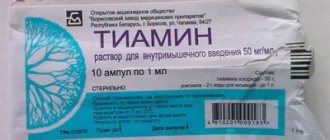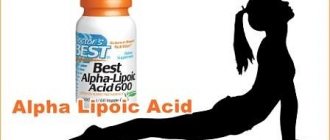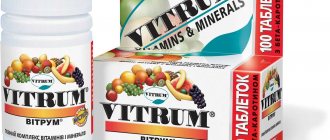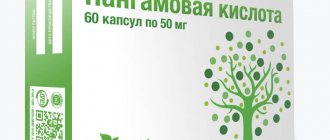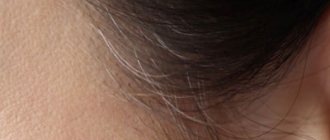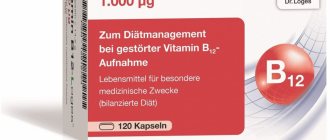Initial appointment with a THERAPIST with 25 years of experience
ONLY 1800 rubles!
(more about prices below)
Vitamin F is a vitamin-like group of three polyunsaturated fatty acids: arachidonic, linoleic and linolenic. It was opened in 1928. Its name comes from the English word “fat”, which means “fat”. Vitamin F cannot be synthesized in the human body, so it is important to obtain it daily from external sources. According to statistics, a deficiency in the consumption of this vitamin is observed in about 80% of the adult population of St. Petersburg.
If you have such an opportunity, it is best to take vitamins by injection for medicinal purposes, since their bioavailability or absorption by the body is higher when administered by injection.
Vitamin F deficiency
The recommended daily dose of vitamin F is about 1-2 g. With a lack of vitamin F, the following occurs:
- fatigue;
- dry skin, eczema;
- frequent colds;
- menstrual irregularities;
- male infertility;
- swelling on the face;
- brittle nails;
- decreased concentration.
If you feel a lack of vitamin F, I recommend including the following dishes in your menu:
- salad of fresh vegetables and mussels;
- fried eggs with avocado;
- scallop stewed in cream.
| Service | Price | Promotion Price |
| Beauty-cocktail (11 blood tests, 10 Beauty-drips, appointment with a therapist) | 39,000 rub. | RUB 35,555 |
| Immuno Protect program (2 blood tests, Immuno Protect droppers, appointment with a therapist) | RUR 7,777 5 sessions | RUB 11,111 10 sessions |
| Anti-age program (blood test for vitamin B 1, B5, B6, B12, C, E, K, D, IVs with an individual vitamin complex, appointment with a therapist) | RUB 21,111 5 sessions | RUB 25,555 10 sessions |
| Anti-stress program (7 blood and urine tests, 10 Anti-stress droppers, appointment with a therapist) | 35,000 rub. | RUB 29,999 |
| Detox program for comprehensive body cleansing (10 droppers, 10 autohemotherapy, tests, appointment with a therapist) | 17,000 rub. | 13,500 rub. |
| Recovery course of IVs after COVID-19 (Coronavirus) | 4050 rub. 5 sessions | 8100 rub. 10 sessions |
| Vitamin therapy (course of 10 intramuscular injections, consultation with a therapist) | 4,000 rub. | 3,000 rub. |
| Intravenous drip administration of drugs (without drugs, 1 bottle) | 800 rub. 1 session | RUB 3,375 5 sessions 6,750 rub. 10 sessions |
| Intravenous drip administration of medications (with existing clinic medications, 1 bottle) | 950 rub. 1 session | 4,050 rub. 5 sessions 8,100 rub. 10 sessions |
| Intravenous drip administration of drugs (without drugs, 2 bottles) | 950 rub. 1 session | 4,050 rub. 5 sessions 8,100 rub. 10 sessions |
| Intravenous drip administration of medications (with existing clinic medications, 2 bottles) | 1100 rub. 1 session | 4,700 rub. 5 sessions 9,400 rub. 10 sessions |
| Intravenous administration of drugs (course) | 450 rub. 1 session | RUB 2,140 5 sessions 4,050 rub. 10 sessions |
| Intravenous administration of immunoglobulin (without the cost of the drug) | 3500 rub. | |
| Dropper of Human Immunoglobulin - Imbioglobulin 50 mg/ml, 20 ml (price includes the cost of the drug) | 7500 rub. | |
| Dropper of Human Immunoglobulin - Imbioglobulin 50 mg/ml, 50 ml (price includes the cost of the drug) | 10500 rub. | |
| Dropper of Human Immunoglobulin - Octagam 50 mg/ 50 ml (price includes the cost of the drug) | 14,000 rub. | |
| Dropper of Human Immunoglobulin - Octagam 50 mg/100 ml (price includes the cost of the drug) | 29,000 rub. | |
| Dropper of Human Immunoglobulin - Octagam 50 mg/200 ml (price includes the cost of the drug) | 49,000 rub. | |
| Dropper of Human Immunoglobulin - Intratect 50 mg/ 50 ml (price includes the cost of the drug) | 14,000 rub. | |
| Dropper of Human Immunoglobulin - Intratect 50 mg/100 ml (price includes the cost of the drug) | 29,000 rub. | |
| Dropper of Human Immunoglobulin - Intratect 50 mg/200 ml (price includes the cost of the drug) | 49,000 rub. | |
| Appointment (examination, consultation) with a general practitioner to prescribe IVs | 1,800 rub. primary | 1,500 rub. repeated |
| Autohemotherapy | 550 rub. 1 session | 2,500 rub. 5 sessions 5,000 rub. 10 sessions |
| Plasma therapy of the spine and joints | 4500 rub. 1 session | 10,500 rub. 3 sessions 17,500 rub. 10 sessions |
| Subcutaneous-intradermal administration of drugs (course) | 250 rub. 1 session | RUB 1,180 5 sessions 2,250 rub. 10 sessions |
| Intramuscular administration of drugs (course) | 300 rub. 1 session | RUB 1,575 5 sessions 2,700 rub. 10 sessions |
Author: Telegina Natalya Dmitrievna
Therapist with 25 years of experience
>
Vitamins in dermatology. Review article
Vitamins include a group of organic compounds that are present in small quantities in cells and catalyze various chemical reactions. It is known that almost all hypovitaminosis is accompanied by certain changes in the skin and its appendages. In dermatovenerology, vitamins and their various complexes are used for nonspecific immunomodulatory therapy, which changes the body’s relationship with etiopathogenetic factors and drugs used to treat this disease.
Vitamins are divided into two classes:
- water-soluble: thiamine, riboflavin, nicotinic acid, pantothenic acid, pyridoxine, folic acid, cobalamin, ascorbic acid, biotin,
- fat-soluble: retinol, calciferol, tocopherol, phylloquinone.
Water-soluble vitamins
Thiamine (vitamin B1) controls the most important processes of energy production and biosynthesis of living cell substances. This vitamin is involved in the metabolism of carbohydrates, nucleic acids, proteins, and lipids. The action of thiamine is characterized as hyposensitizing, analgesic, antipruritic, anti-inflammatory; it stimulates the detoxification function of the liver and has a beneficial effect on the state of the central nervous system. Thiamine stimulates melanogenesis, as well as the synthesis of connective tissue elements. Changes in lipid peroxidation in the body of thiamine have been reported; in particular, an increase in the permeability of lysosomal and plasma membranes of leukocytes has been established. There are observations about the participation of thiamine in immunological reactions. The action of this vitamin is realized by activating the biosynthesis of nucleic acids and proteins, which underlies the proliferation of both thymocytes and bone marrow cells. With thiamine deficiency, both cellular and humoral immunity are inhibited.
Thiamine is recommended for eczema, psoriasis, lupus erythematosus, for diseases with photosensitivity - photodermatoses: porphyrin disease, lupus erythematosus, pellagra; as well as neurodermatitis, pruritus, chronic urticaria, skin itching, seborrhea, lichen planus, when the peripheral nervous system is involved in the pathological process in patients with herpes zoster, leprosy, as well as in the complex treatment of vitiligo, circular and seborrheic hair loss, chills, cheilitis , acne vulgaris, pyoderma, candidiasis.
On the other hand, a dermatologist in his practice may encounter negative effects of vitamin B1 caused by allergic reactions: urticaria, skin itching, Quincke's edema, erythroderma. A manifestation of increased sensitivity to thiamine under conditions of its production is contact dermatitis.
Riboflavin (vitamin B2) is involved in energy metabolism processes. It is part of tissue respiration enzymes and affects the metabolism of nucleic acids, proteins, carbohydrates, and lipids. This vitamin has a beneficial effect on the processes of growth, regeneration and trophism of tissues, is closely related to the metabolism of a number of other vitamins, and stimulates phagocytosis and melanogenesis.
If there is a deficiency of riboflavin in the body, wounds and trophic ulcers do not heal well.
Riboflavin preparations are effective in combination with other drugs for cheilitis, angular and aphthous stomatitis, glossitis, cracked lips, seborrheic dermatitis, alopecia, rosacea, photodermatoses, psoriasis, eczema, neurodermatitis, prurigo, acne vulgaris, streptoderma. Vitamin B2 is indicated for long-term use of antibiotics, sulfonamides, hormones, and antimalarial drugs, which are often used in dermatology. The stimulating effect of riboflavin in trophic disorders in tissues, as well as its participation in the regeneration process, make it possible to use this vitamin for the treatment of burns.
Nicotinic acid (vitamin PP or B3) is part of the enzymes of redox reactions, affects the metabolism of carbohydrates, lipids, proteins, reduces blood glucose, improves the functional state of the central nervous system, liver and stomach, and participates in the reparative processes of the skin.
With a lack of nicotinic acid, pellagra develops (Italian pelle - skin, agro - rough). The main manifestations of pellagra are photodermatitis and inflammatory lesions of the mucous membrane of the oral cavity and tongue. Dermatitis is located mainly in open areas. Erythematous in the acute period, it is accompanied by itching or burning. Then, within 2 - 3 weeks, it becomes dry and scaly, and the skin thickens. Collar of Kasal is a term used to describe sharply defined skin lesions that form around the neck, resembling a necklace. Skin lesions also occur on areas of bony prominences and on the face. When nicotinic acid is added to the diet, the skin symptoms of pellagra quickly disappear centrifugally. A decrease in the content of nicotinic acid in the body has been established in psoriasis, eczema, and photodermatoses.
Due to the vasodilating effect of nicotinic acid, it is successfully used to treat chills, chronic acrodermatitis atrophicus, Raynaud's disease and scleroderma, and due to its beneficial effect on the nervous system and liver function, it is used to treat eczema, neurodermatitis, prurigo, lichen planus, and psoriasis. The photodesensitizing effect of vitamin PP allows it to be used for photodermatoses, and its beneficial effect on the functional state of the digestive tract allows it to be used for erythematosus. Due to the ability of this vitamin to prevent and reduce toxic effects, it is recommended to prescribe it for long-term use of high doses of antibiotics, sulfonamides, antimalarial drugs, as well as in combination with other drugs - for cheilitis, stomatitis. The use of nicotinic acid gives a good effect on sluggishly healing wounds and ulcers. Nicotinic acid is prescribed to obtain the phenomenon of inflammation in the diagnosis of syphilitic roseola and erythema leprosum.
Patients suffering from allergic dermatoses during periods of severe allergic conditions (allergic dermatitis, eczema, urticaria) should not be prescribed the drug. Side effects include redness of the skin of the face and upper half of the body, increased skin temperature, sometimes itching and urticarial elements.
Pantothenic acid (vitamin B5). It has been established that pantothenic acid takes part in the metabolism of carbohydrates, fats, proteins, and participates in redox processes and in melanogenesis.
Pantothenic acid is used in dermatological practice as a dermatoprotector, because it has a regenerating and anti-inflammatory effect. It is used in the treatment of atopic dermatitis, eczema, trophic ulcers, burns, herpes, alopecia and dermatoses of various etiologies.
Pyridoxine (vitamin B6) catalyzes processes that regulate the metabolism of nucleic acids, proteins, fats, and carbohydrates.
Pyridoxine deficiency leads to the development of anemia, functional changes in the central nervous system, seborrheic dermatitis, glossitis, cheilitis, and hair loss.
Vitamin B6 is used to treat dermatoses in which there is a significant lack of pyridoxine in the body - seborrhea, stomatitis, psoriasis, scleroderma, herpes zoster, photodermatoses, atopic dermatitis.
The drug is indicated for patients suffering from neurodermatitis and eczema. Pyridoxine prevents and reduces toxic effects in people taking high doses of antibiotics, antimalarial and antituberculosis drugs for a long time.
A positive clinical effect was established in patients with acne vulgaris, for the treatment of which a cosmetic cream containing 0.5% pyridoxal phosphate was used.
The use of the drug in dermatological practice for psoriasis, eczema, and neurodermatitis is associated with its ability to stimulate metabolic processes in the skin and mucous membranes. In patients with psoriasis, the use of pyridoxal phosphate is pathogenetically justified by a deficiency of pyridoxine and a violation of tryptophan metabolism at the level of the B6-dependent enzyme.
Allergic reactions to pyridoxine are possible - skin itching, urticaria, toxicoderma.
Folic acid (vitamin B9). Folic acid plays an important role in the metabolism of serine, glycine, histidine, and the biosynthesis of DNA and RNA molecules. It is also essential for the normal course of the processes of growth, development, tissue proliferation, and melanogenesis.
The administration of folic acid is accompanied by a clinical effect for psoriasis, solar urticaria, pruritus, porphyria cutanea tarda, rosacea, cheilitis, hyperkeratosis, dermatitis herpetiformis, pyoderma, acne, radiation damage to the skin, as well as with prolonged use of cytostatics, antibiotics, sulfonamides. Thus, the combination of methotrexate with folic acid in the treatment of patients with psoriasis significantly reduces the incidence of such serious side effects as anemia, leukopenia, thrombocytopenia.
Folic acid is classified as a vitamin that is characterized by severe toxicity, since even a single administration of it to a person in a dose of more than 100 mg causes symptoms reminiscent of histamine poisoning - severe redness of the face, an itchy maculopapular rash, etc. Positive skin tests in some cases indicate about the allergic nature of such phenomena.
Cobalamin (vitamin B12). The ability of cobalamin to increase nonspecific resistance to bacterial infections has been established. One of the basis of the mechanism of the immunomodulatory action of this vitamin is considered to be its effect on the exchange of nucleic acids and proteins.
Vitamin B12 is successfully used for psoriasis, photodermatoses, dermatitis herpetiformis, and neurodermatitis.
When cobalamin is administered, allergic reactions in the form of urticaria and Quincke's edema are possible. The combined use of cobalamin with thiamine more often causes the development of allergic reactions than separate use. In case of a pronounced hyperergic state during the period of exacerbation of eczema and neurodermatitis, the administration of cobalamin can enhance allergic reactivity, therefore, in the acute stage of dermatoses, the use of this vitamin should be avoided. A similar tactic is advisable for the progressive stage of psoriasis, psoriatic erythroderma and its arthropathic form.
Ascorbic acid (vitamin C) is involved in the formation of connective tissue, the metabolism of proteins, carbohydrates, lipids, the synthesis of adrenal hormones, nucleic acids, has a beneficial effect on regenerative processes, regulates pigment metabolism in the skin, stimulates the antitoxic function of the liver, the activity of the endocrine glands, promotes adaptive abilities of the body. Ascorbic acid preparations are characterized by antitoxic, hyposensitizing, anti-inflammatory, and antihyaluronidase effects. In vitro, the bacteriostatic and bactericidal role of vitamin C in relation to staphylococcus and streptococcus was revealed.
Vitamin C deficiency leads to disruption of the T-immune system and less significant deviations of humoral immunity. The fact of melasma due to vitamin C deficiency is widely known. Violation of collagen synthesis with vitamin deficiency is reflected in poor wound healing.
The positive effect of ascorbic acid has been noted in inflammatory, degenerative and other pathological processes of the skin. The administration of ascorbic acid is advisable for toxicoderma, allergic dermatitis, eczema, neurodermatitis, prurigo, chronic urticaria, lichen planus, photodermatoses, vasculitis, pemphigus, stomatitis, glossitis, chronic atrophic acrodermatitis, chronic pyoderma, acne vulgaris, alopecia alopecia, mycoses of the feet, a also with prolonged use of corticosteroid drugs and antimalarials. In the treatment of diseases manifested by vascular pathology of the skin, the effectiveness increases with the combination of ascorbic acid and rutin.
Biotin (vitamin H) is an organic acid that participates in numerous carboxylation reactions. Biotin deficiency is accompanied by alopecia, dryness, scaly skin (seborrhea), skin hyperesthesia, swelling and atrophy of the tongue papillae.
Used in the treatment of atopic dermatitis, psoriasis, eczema, alopecia, seborrhea. A good clinical effect was obtained when treating acne vulgaris with high doses of biotin.
Fat-soluble vitamins
Vitamin A (retinol). In terms of the variety of reactions in which retinol is involved, it ranks first among vitamins. Retinol affects the processes of reproduction and growth, redox processes, the metabolism of proteins, carbohydrates, lipids, the synthesis of corticosteroids and sex hormones, nucleic acids. Retinol is involved in the regeneration of epithelial tissues and regulates the processes of keratogenesis. The important function of retinol has been established as maintaining the stability of plasma and subcellular membranes. At the same time, retinol hypervitaminosis leads to shifts in the activity of phospholipases, which play an important role in changes in the composition of biomembranes. The antioxidant properties of retinol have been established. The ability of the vitamin to have an immunomodulatory effect is noted. This vitamin causes a relative and absolute increase in the content of B-lymphocytes in the peripheral blood. With retinol deficiency, antibody formation is inhibited. The ability of this vitamin to relieve the immunosuppressive effects of glucocorticoids is known.
Retinol deficiency in the body naturally manifests itself as a violation of the processes of keratinization of the skin and mucous membranes, especially the oral cavity; brittle nails, hair loss, phrynoderma (Greek Phrynos - toad) - follicular keratosis, in which areas of keratinization are surrounded by a zone of depigmentation on the skin of the upper arms and legs, are noted. Then it moves to the torso, back, stomach and neck. Lesions on the face may resemble comedones due to inflammation of the sebaceous glands of the hair follicles.
The beneficial effect of retinol in inflammatory, degenerative and other pathological processes of the skin serves as the basis for its widespread use in dermatological practice. This vitamin is effective for diseases accompanied by hypertrophy of the stratum corneum of the epidermis (all forms of ichthyosis, follicular keratosis, hyperkeratosis of the palms and soles). It is used in the treatment of dermatoses, which are characterized by disturbances in the processes of keratinization (psoriasis), the secretory function of the sebaceous glands (seborrhea, seborrheic alopecia, acne vulgaris), with damage to the mucous membranes (leukoplakia), nail dystrophy, hair growth disorders (dryness and increased fragility, monilethrix (Latin monile necklace + Greek thrix hair; - hereditary hair dystrophy, manifested by alternating spindle-shaped thickenings of the hair shaft with areas of thinning, dryness, fragility and hair loss. In combination with other agents, retinol is useful in the treatment of eczema, chronic ulcerative pyoderma, trophic ulcers, Raynaud's disease. Taking into account the pronounced antioxidant properties of retinol, its combination with tocopherol acetate and 0.5% selenium ointment has been successfully used in the treatment of psoriasis and baldness.
Hypervitaminosis A is also characterized by dermatological manifestations: rash, itching, pigmentation, yellow discoloration of the skin of the palms and soles, delayed wound healing, hair loss. Seborrheic rashes and bleeding of the mucous membranes of the mouth may be observed on the skin.
Retinoids, being synthetic derivatives of vitamin A, have significantly expanded therapeutic options for a number of dermatoses, including severe ones and those resistant to other medications. Synthetic retinol derivatives - aromatic retinoids - are hundreds of times less toxic than their natural predecessor, so they can be used in the clinic in fairly large doses for a long time. Etretinate (tigazone) and 13-cis-retinoic acid (isotretioin) have found use in clinical practice.
The influence of retinoids is characterized by an amazing variety of biological effects. In practical terms, the most significant is their antitumor and immunostimulating effect; When these drugs are prescribed in patients, the total number of lymphocytes in the blood and the number of T cells significantly increases.
Isotretinoin (the commercial name of the drug is “Roaccutane”), which has a sebostatic effect (inhibits the secretion of the sebaceous glands), is used in the treatment of various forms of acne. Among the side effects during the period of taking maximum doses of Roaccutane, in some cases, increased dryness of the skin is observed, especially around the mouth, mucous membranes of the oral cavity, as well as dermatitis of the facial skin, weeping, itching, and reversible alopecia.
Another retinoid, tigazone, due to its antiproliferative effect, has been effective in the treatment of psoriasis. The effectiveness of treatment increases significantly when etretinate is combined with photochemotherapy. The authors recommend such an integrated approach in the treatment of patients with widespread, often recurrent psoriasis.
There is evidence of a favorable clinical result of the use of tigazon in the treatment of patients with lichen planus of the oral mucosa, subacute lupus erythematosus, hyperkeratotic eczema of the hands and feet, palmoplantar hyperkeratosis, pustulosis of the palms and soles, and ichthyosis of various forms.
The most common complications of taking tigazone include dry mucous membranes, itching, hair loss, and excessive peeling of the palms and soles.
Calciferol (vitamin D). The skin plays a major role in the production of vitamin D, where it can be actively synthesized by keratinocytes, fibroblasts and macrophages under the influence of UV rays.
The action of the vitamin is realized by regulating phosphorus-calcium metabolism; it also has a regulating effect on the state of the autonomic nervous and vascular systems, increases sweating and sebum secretion, improves hair growth, and normalizes water metabolism in the skin. Many tissues have receptors for calcitriol, so it is thought to have a variety of functions that are not yet understood. Thus, its active influence on cell differentiation in normal and tumor tissues has recently been established.
Due to the wide range of biochemical activity of calciferols, they are used in the treatment of tuberculous lupus, scrofuloderma, and chromomycosis. The literature describes a case where the administration of vitamin D for senile osteoporosis led to regression of concomitant psoriasis in the patient, which served as the basis for the use of vitamin D in the treatment of this disease.
Calciferol can cause acute poisoning with symptoms of hemorrhagic vasculitis. With prolonged use of high doses of the vitamin, pustular and acne-like rashes and general sweating may occur. These phenomena are reduced with the combined use of calciferol with retinol, thiamine and ascorbic acid.
Tocopherol (vitamin E) affects the metabolism of proteins, carbohydrates, nucleic acids and steroids, promotes the accumulation of retinol and other fat-soluble vitamins in the body, exhibits anti-inflammatory and antithrombotic effects, reduces the permeability of the vascular wall, and acts as an antioxidant. Protecting lipids from peroxidation is one of the most studied functions of vitamin E. Since unsaturated lipids are a component of biological membranes, this function of tocopherol is very important for maintaining the structural integrity and functional activity of lipoprotein cell membranes and subcellular structures. The immunostimulating properties of tocopherol are realized by inhibiting the activity of T-suppressors. At the same time, vitamin E significantly increases the activity of natural killer cells.
The use of vitamin E is indicated for ichthyosis, dermatomyositis, scleroderma, Raynaud's disease, photodermatoses, psoriasis, ulcerative stomatitis, poorly healing leg ulcers, X-ray ulcers, acne vulgaris, seborrhea, nested hair loss, as well as for dermatoses associated with dysfunction of the gonads. Good clinical results have been established with the combined administration of tocopherol acetate, retinol and 0.5% sodium selenite ointment to patients suffering from psoriasis and alopecia alopecia.
Vitamin E is also used externally in dermatology - in the form of an oil concentrate or an ointment containing 3% tocopherol acetate.
Vitamin K (phylloquinone) is involved in blood clotting, enhances the anti-inflammatory effect of steroid hormones, affects tissue regeneration, increases resistance to infections, and has an analgesic effect. Vitamin K deficiency leads to the development of hemorrhagic syndrome.
The use of vitamin K is indicated for burns and frostbite, radiation injuries, dermatoses with a hemorrhagic component, ulcerative stomatitis, gingivitis, and dermatomyositis.
Vitamin-like compounds
Lipoic acid (vitamin F) is part of a multienzyme complex involved in the decarboxylation of pyruvic acid, exhibits a pronounced hepatotropic and weak hypoglycemic effect, activates the consumption of glucose and pyruvate by tissues, reduces the content of cholesterol and total lipids in the blood serum, stimulates phosphorylation and protein biosynthesis in the liver.
The effectiveness of lipoic acid in psoriasis and dermatoses accompanied by impaired liver function and lipid metabolism has been established.
With prolonged use of lipoic acid, allergic skin reactions are possible.
Calcium pangamate (vitamin B15) affects lipid and carbohydrate metabolism, increases the activity of respiratory chain enzymes, and therefore significantly increases the absorption of oxygen by tissues. Due to the lipotropic effect of the vitamin, the total content of lipids in the liver, as well as cholesterol, decreases, the production of glucocorticoids increases, and a detoxifying effect is observed.
Calcium pangamate is successfully used for psoriasis, pruritus, skin itching, toxicoderma, as well as to improve the tolerability of corticosteroid and sulfonamide drugs.
Rutin (vitamin P). The vitamin P group includes a number of substances - bioflavonoids, which have the ability to reduce the permeability and fragility of capillaries.
The physiological effect of the vitamin is realized through the endocrine glands, through its influence on the enzyme systems involved in tissue respiration. Vitamin P preparations exhibit antihistamine effects and antioxidant properties. Rutin regulates free radical homeostasis through several mechanisms. Firstly, it neutralizes the most dangerous radicals (peroxynitrite and hydroxyl), and secondly, it controls the production of physiologically important radicals (superoxides) by cells. In addition, rutin stimulates the release of nitric oxide, the main stimulator of relaxation of the muscles of the vascular wall.
With vitamin P deficiency in the body, characteristic changes are noted in the form of small intradermal hemorrhages (petechiae), which occur spontaneously, especially in areas of pressure, and disappear after the administration of bioflavonoids.
The use of vitamin P is advisable in case of increased permeability of blood vessels and their fragility (hemorrhagic diathesis, capillary toxicosis). The effectiveness of vitamin P has been noted for toxicoderma, allergic dermatitis, eczema, urticaria, vasculitis, exudative form of psoriasis, erythroderma, Dühring's dermatosis, and radiation dermatitis.
Along with vitamin P, it is advisable to prescribe ascorbic acid.
Methylmethionine sulfonium chloride (vitamin U), being a donor of methyl groups, is involved in the biotransformation of various xenobiotics, as well as the methylation of histamine, which provides an antihistamine effect. When studying the autoflora of workers involved in the production of methylmethionine sulfonium chloride, a significant increase in the number of microbes was found, an increase in the number of hemolytic forms of microorganisms and yeast-like fungi. Such changes are regarded as evidence of the possibility of a nonspecific effect of vitamin production products on the general reactivity of the body.
Vitamin U has proven to be somewhat effective in the complex treatment of patients with psoriasis, especially patients with concomitant diseases of the gastrointestinal tract.
The material was prepared by dermatocosmetologist S.N. Lyshkanets
Why is deficiency dangerous?
Most often, vitamin F deficiency occurs in childhood (up to 1 year). It manifests itself as weight loss, stunted growth, peeling and thickening of the skin. The child may also have loose stools and a greater need for water with minimal diuresis.
In adults, reproductive functions are suppressed, infectious and cardiovascular diseases occur. The area of the face, back and chest becomes covered with acne. This happens due to disruption and blockage of the sebaceous glands. In clogged follicles, pathogenic bacteria quickly multiply. In some cases, small ulcers form, sometimes necrosis. In addition, skin pigmentation changes.
When lipid metabolism, blood supply and tissue nutrition are disrupted, pathologies of the musculoskeletal system develop. Later, radiculitis, osteochondrosis and rheumatoid arthritis are diagnosed. With long-term vitamin F deficiency in adults, the risk of developing atherosclerosis, arterial hypertension and their complications – stroke and heart attack – increases.
Additional symptoms of vitamin F deficiency: allergic diseases, seborrhea, brittle nails, dullness and hair loss, cracks in the skin and mucous membranes (including anal ones).
What products contain
Most vitamin F is found in vegetable oils.
Unsaturated fatty acids are also found in animal fats, nuts, beans, and seafood. Table of vitamin F content in food
| The product's name | Amount of vitamin F (in g) |
| Fish fat | 99,9 |
| Cod liver | 15 |
| Olive oil | 9 |
| Linseed oil | 18,1 |
| Rapeseed oil | 10,3 |
| Grape seed oil | 70 |
| Sesame oil | 41 |
| Sunflower oil | 66 |
| Mustard oil | 16 |
| Corn oil | 54 |
| Cottonseed oil | 52 |
| Walnut oil | 53 |
| Soybean oil | 50 |
| Peanut butter | 32 |
| Hemp seed | 8,1 |
| Pumpkin seeds | 5 |
| Dry soybeans | 1,6 |
| Walnuts | 6,8 |
| Oat germ | 1,4 |
| Halibut | 1,8 |
| Mackerel | 5,3 |
| Herring | 3,1 |
| Salmon | 2,3 |
| Trout | 2,6 |
| Tuna | 3,2 |
How does it affect the skin?
The benefits of vitamin F have been clearly proven. If you pick up a tube of skin cream, this vitamin is sure to be present in the composition, because thanks to it our skin glows with health and shines in the sun. When working together with other vitamins, a powerful antioxidant effect occurs in our body.
For any damage to the skin, it has an immediate effect on the affected area. For various skin diseases, be it eczema or dermatitis, it leads to a speedy recovery. One has only to apply the drug to the skin, saturated with this element.
When it comes to cosmetics, vitamin F always comes first. It retains moisture on the skin, making it elastic and pleasant to the touch, which prolongs the youth of your skin.
Reference! The drug can be purchased at the pharmacy in the form of tablets or ampoules.
Benefit
The main function of vitamin F is to normalize fat metabolism, participate in the absorption of fats and remove dangerous cholesterol from the body. The substance is also necessary for the functioning of the cardiovascular system. It prevents the accumulation of cholesterol plaques in blood vessels and arteries, improves blood circulation, and normalizes the pulse. With regular use, excess weight is gently lost. This has a positive effect on the health of obese people.
Vitamin F helps eliminate inflammatory processes in the body. It affects reproductive function, improves lactation and tissue nutrition, stimulates muscle function, and has an anti-sclerotic effect. In addition, it deeply moisturizes the skin, providing it with a healthy appearance.
When taken simultaneously with vitamin D, fatty acids improve the absorption of phosphorus and calcium. This is important for bone tissue. Regular use of the substance promotes maximum absorption and increased activity of vitamins A, D, E and all types of group B.
Vitamin F is used for the treatment and prevention of atherosclerosis, bronchial asthma, cancer and immunodeficiency diseases, and diabetes. It is very important for the musculoskeletal system. With proper nutrition of joint tissues, the substance prevents the development of rheumatoid diseases and osteochondrosis.
Linoleic acid takes part in the synthesis of prostaglandins. These substances can normalize blood pressure.
Vitamin F has many other functions:
- stimulates the immune system;
- treats skin diseases (dermatitis, eczema, allergic manifestations);
- protects skin from early aging;
- improves the process of sperm maturation;
- supports the health of the gastrointestinal mucosa, hair and nails.
Indications for use
If you notice any changes in your skin or your skin has become dry and not elastic, then it’s time for you to pay attention to the level of vitamin F in your body. In addition, there are several other factors to worry about. Let's look at the list of indications:
- Abnormalities in the functioning of the heart.
- Working with heavy loads on the muscles.
- Mental work leading to increased brain function.
- Diets that exclude a sufficient amount of fat from the diet.
- Children have retardation in physical or intellectual development.
It is important! During pregnancy or breastfeeding, it is also recommended to supplement your diet with foods high in vitamin F.
TOP 5 drugs
You can fight hypovitaminosis if you buy the required type of vitamin separately, but it is more convenient to use multivitamins with a balanced composition. Choosing good drugs at the pharmacy is difficult; you need to take many parameters into account. To do this, you can make an appointment with a doctor, read reviews or focus on the TOP 5 drugs for women of different ages.
SOLGAR, Laboratoires INELDEA, Nature's Bounty, FINE JAPAN, INFINITY, UNIMAT - you can select a complex based on age or health status. The manufacturer offers multivitamins for girls leading an active lifestyle and for those preparing for motherhood. You can buy a special drug for women over 45 years old; for older people there are tablets with vitamin D and calcium and many other multivitamin complexes.
- Orthomol is a line of vitamin products for women, which are available in capsules, drinking liquid and granules for preparing a solution. Contains all the necessary substances to maintain health at different ages.
- Vitrum - includes micro- and macroelements in the required dosages. For young girls there are medicines from the Beauty series, and for older girls - Beauty Elit, they contain substances that allow you to strengthen your nails and maintain the beauty of your hair. There are medications for pregnancy planning that contain omega-3 acids.
- Dopelgerts Active menopause - a vitamin complex for women after menopause. The peculiarity is that it contains all the necessary substances for the prevention of heart disease and osteoporosis.
- Duovit is a drug for women that can be taken at any age. The tablets are divided into two types depending on the compatibility of the components.
If you take vitamin supplements comprehensively from the age of 20, you can maintain a high level of health. Prevention from age 50 will prevent the early development of osteoporosis. In adulthood, there are many concomitant diseases that require adjustments in vitamin intake. This was not provided for in the previous generation of drugs, but you can purchase new products that are specially designed for patients with cardiovascular pathologies, diabetes mellitus or joint diseases.


